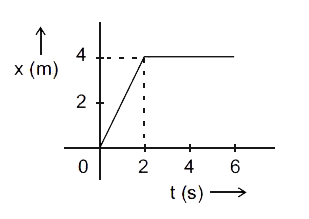In the figure given below, the position-time graph of a particle of mass 0.1kg is shown. The impuslse at t=2 sec is

A
0.2kgm/s
B
−0.2kgm/s
C
0.1kgm/s
D
−0.4kgm/s
Video Solution
Text Solution
The correct Answer is:B
Between t=0 and t=2s ,
v= slope of x -t graph =42=2m/s
t>2s,v=0
Δp=p2−p1=0−mv=0−0.1×2=−0.2kgm/s
|
Topper's Solved these Questions
Similar Questions
Knowledge Check
In the figure given below, the position time graph of a particle of mass 0.1kg is shown. The impulse at t=2 sec is
 A0.2gkm/secB−0.2kgmsec−1C0.1kgmsec−1D−0.1kgm/sec
A0.2gkm/secB−0.2kgmsec−1C0.1kgmsec−1D−0.1kgm/secIn the figure given below, the position–time graph of a particle of mass 0·1 kg is shown. The impulse at t=2sec is
 A0⋅2 kgmsec −1B−0⋅2 kgmsec −1C0⋅1 kgmsec −1D−0⋅4 kgmsec −1
A0⋅2 kgmsec −1B−0⋅2 kgmsec −1C0⋅1 kgmsec −1D−0⋅4 kgmsec −1In the figure given, the position-time graph of a particle of mass 0.1 kg is shown the impulse at t = 2s is
 A0.2 kg m/sB−0.2 kg m/sC0.1 kg m/sD−0.4 kg m/s
A0.2 kg m/sB−0.2 kg m/sC0.1 kg m/sD−0.4 kg m/s
Shows position time graph of a particle of mass 100g Find the impulse at t=0 and at t=4s
 .
.
View SolutionThe position-time graph of a particle of mass 0.1 kg is shown. The impulse at t = 2s is :

View SolutionPosition time graph of a particle of mass 2 kg is shown in figrure. Total work done on the particle from t=0 to t=4s is

View SolutionThe velocity − time graph of a particle is as shown in figure

View SolutionFigure shows the position time graph of a particle of mass 5kg. The force acting on the particle for 0<t<4s and 8s<t<12s respectively are,

View Solution


